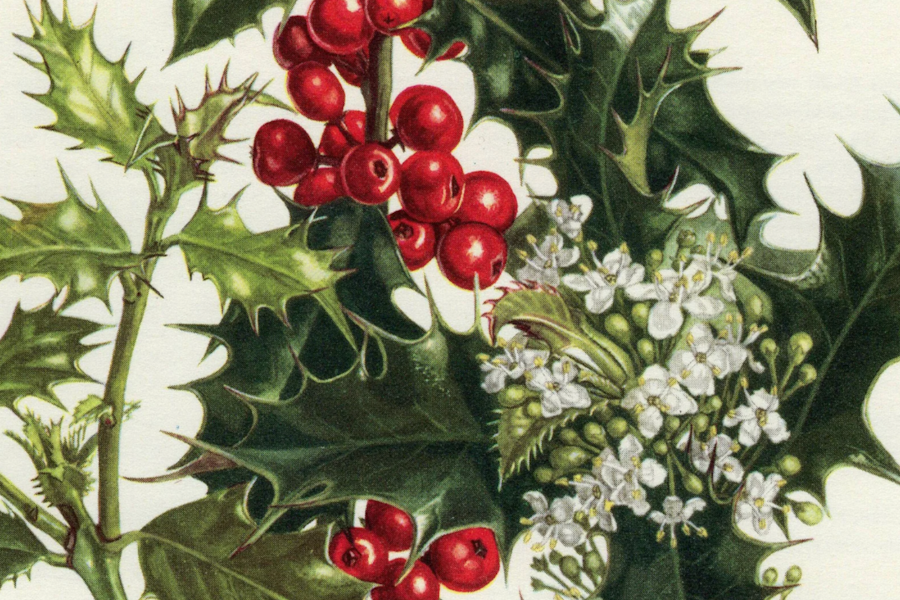The house we eventually bought when we moved back to Virginia is a 1960 brick ranch. Neat and trim, it testifies to all we know to be true about the community around it. Its hardwood floors, copper pipes, and eat-in kitchen are unpretentious, sensible, and built to last. This aesthetic also explains the presence of the six holly bushes once planted along its front. Because holly is evergreen and fairly low maintenance, it is a good, practical choice for landscapes and gardens, especially for people whose lives are too busy to tend fussier ornamentals. But holly’s delicate white flowers produce a significant amount of pollen just when you want to throw the doors and windows open. Their location so close to the house combined with our youngest son’s extreme springtime allergies meant that these bushes had to go.
This was easier said than done. At first, Nathan tried to dig them out, but their extensive root system kept them firmly planted. Undeterred, he opted for force, wrapping a chain around the base of one and attaching it to the bumper of his truck. One bent bumper later, it was obvious who was winning. Eventually, he recruited help in the form of a passing neighbor with a bigger truck, and soon enough, the additional torque and horsepower ripped the bushes from the earth. You’d think we’d finally won. And yet a decade later, we’re still pulling up shoots from the taproots that were left behind.
Holly’s perseverance, both as an evergreen and a deeply rooted shrub, is misrepresented by the neat, domesticated versions we often find in neighborhood landscaping. In the wild, some varieties of holly grow up to eighty feet tall and forty feet wide, making it more like a tree than a bush. The ancients saw this as a sign of nature’s endurance and a promise that spring would return. The Romans incorporated holly into their worship of Saturn, and the Druids believed it warded off evil spirits. Eventually, it became a mainstay of Christian tradition, especially during the seasons of Advent and Christmas when its glossy leaves and bright red berries were used to “deck the halls.” In fact, medieval church accounts record holly being used in church decorations from at least the twelfth century.1But holly was more than a convenient seasonal decoration.
For the early and medieval church, the natural world held spiritual mysteries within itself, standing as a kind of physical manifestation of truth. Holly was a shrub, but it was more than that. This may seem a bit too mystical for us in the modern West, but don’t forget that we live in a world of universal and compulsory education focused almost exclusively on the development of the mind. From our earliest days, we’re taught the meaning behind the letters and numbers on a page. But imagine a time in which books do not exist — or at the very least, they are the purview of the wealthy and powerful. In such a world, learning to decode the meaning behind a collection of letters would be far less useful than learning to decode the meaning behind the natural world around you. This did not mean people were unintelligent, merely that their shared knowledge base was different from ours. And so for generations of Christians before us, natural revelation was the means of communicating spiritual truth.
I think about this — how God’s work is not bound by education or class — when I read about Simeon in Luke 2:25. Introduced to us simply as “a man in Jerusalem,” the most important thing about Simeon is that he is “righteous and devout, looking forward to Israel’s consolation, and the Holy Spirit was on him.”2 His presence in the temple might lead you to think he was part of the priesthood like Zechariah, but nothing in the passage suggests this.
He’s in the temple on the day Mary and Joseph came to complete “everything according to the law of the Lord,”3 because the Spirit had led him there. Having been promised by God that he would not die until he saw the coming Son, Simeon is by now an elderly man, longing deeply for the world to be made right. When he sees the infant Jesus, he is overcome with joy, sweeping him up in his arms in an unaffected gesture of pure delight. Then this ordinary man proclaims:
Now, Master,
you can dismiss your servant in peace,
as you promised.
For my eyes have seen your salvation.
You have prepared it
in the presence of all peoples—
a light for revelation to the Gentiles
and glory to your people Israel.4
But Simeon has something else he needs to say. Maybe it was the years of living in the brokenness, the decades of waiting and longing, the wisdom that can only be learned from hard times and hopes crushed a hundred times over, but he knows redemption will not come easily. He knows there is no life without pain, no salvation without suffering. So he turns to Mary with these words:
Indeed, this child is destined to cause the fall and rise of many in Israel and to be a sign that will be opposed — and a sword will pierce your own soul — that the thoughts of many hearts may be revealed.
Scholars interpret these words as prophesying the coming crucifixion and passion of Jesus. And in this sense, they are deeply theological and deeply Christian. Because while the Romans and Druids celebrated holly as a symbol of persevering life, Christians saw something darker hidden among those thorny leaves and red berries. They saw something of its piercing nature. They saw in it a crown of thorns, spilled blood, and life after death. Known in some languages as “Christ thorn,” holly became for them a symbol of Christ’s suffering for the world.
Because one day, the thorns of Genesis 3, the ones that grow up from the cursed ground, would press into the head of the promised Son. They would bite and tear at his flesh, piercing his brow, the sins of the world mocking him. This was the life he was born to, the life he was destined for — to be a Savior for the oppressed, a light to the Gentiles, and a Suffering Servant.
It was also the life Mary was called to share with him, to walk out her faith, not just in the moment of his birth but over the years of his life. Refusing to protect him from his calling and, instead, supporting and participating in it — from his first miracle at the wedding feast to the foot of the cross and the empty tomb. Mary was called to carry the weight of a mother’s heart pierced by her Son’s suffering.
Because just as shoots of holly keep popping up in my front yard, the curse does not go easily. The thorns continue to grow because sin’s roots run deeper than any of us understand. Nothing short of the life and death of the Promised Son can break its grip on this world.
Like Mary, we, too, are called into the suffering of Jesus. To bear witness with the world as it groans for redemption. To proclaim that the blood of the Savior is the only thing that can turn back the thorns. To know that if we follow in his steps, we will find our own hearts pierced as well.
“Dear friends,” writes the apostle Peter, “don’t be surprised when the fiery ordeal comes among you to test you, as if something unusual were happening to you. Instead, rejoice as you share in the sufferings of Christ, so that you may also rejoice with great joy when his glory is revealed.”5
This is a strange kind of joy — one that cannot be explained by sentimentality or celebration. It’s the joy of an old man like Simeon, exhausted and broken by the suffering of the world, holding hope in his arms. It is the joy of a mother like Mary knowing that her child will change everything, but that she will lose him in the process. It is the joy of those of us who have followed this Promised Son in the way of suffering and found him faithful.
It is the joy of the holly tree, the joy of sharp pain and glorious beauty persevering together.


